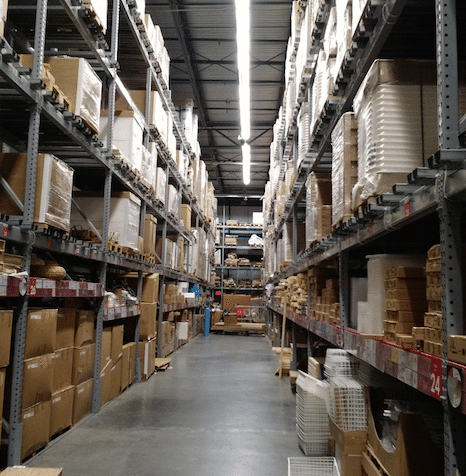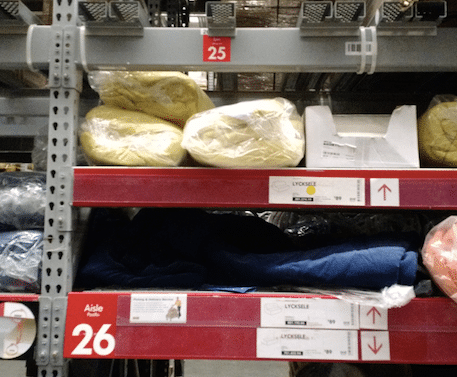
3 Things an IKEA Dresser Can Teach Us about Content Management
Metadata | Taxonomy | Enterprise Content Management (ECM)
Last weekend, we moved my daughter up to New York City.
She started a job today as a nurse at Columbia Presbyterian hospital, and the apartment is on 10th Avenue a bit north of the Port Authority (pizza place on one side of the door, Irish bar on the other, Dunkin Donut down the block – what’s not for me to like?). My wife and I are alternately very proud and terrified of her accomplishment and move. Mostly the former. Her place is in the middle of the picture below by the pride flag.

In the course of the move-in and many illegal parking spaces and Keystone Cop antics associated with doing a move-in in NYC, we decided to add to the lunacy and make a visit to IKEA. In Brooklyn.
Those who know me can testify that IKEA is not one of my usual haunts. Just following those little arrows through the pre-defined maze of bedrooms to kitchens to living rooms to bathrooms gets me a bit dizzy. If not for the meatballs, I would usually rather put a stick in my eye than go to IKEA. But truth be told, amidst my whining, anytime I am forced to go to IKEA, I do have a grudging appreciation for the sophistication of the operation. And for the incredible example it provides of effective Taxonomy and Metadata management in action.
Say what? Taxonomy and Metadata?
At IKEA, I find myself thinking about all the conversations I’ve had with so many people over the years about the impossibility of truly doing content and document management well. About how incredibly gargantuan the task is of organizing all that content. About how nobody can find ever anything. About how the sheer volume of all that content makes the task not just difficult, but impossible. About how even at AIIM (true confessions), with only 30 people and sitting atop the world’s best collection of content about content, we struggle much like the shoemaker’s children to organize our fairly modest content and information assets into something coherent.
For anyone who has managed to somehow avoid the IKEA experience, THIS is what awaits you at the end of your journey.

Endless rows of stuff, just like the one above that bring to mind the huge warehouse at the end of Indiana Jones:

It’s a physical version of the digital landfills we create in our organizations -- huge undifferentiated dumping grounds of beds and dressers and lamps and rugs and sofas that mirror the file shares and SharePoint team sites and Box folders and poorly implemented content management systems in our organizations.
Except something different is going on here. There is a method and a structure to this madness that allows people – regular people, none of whom appear to be actually Swedish and none of whom appear to be card-carrying members of the American Production Inventory Control Society – to navigate this incredible inventory of “stuff” on their own and with a minimum of supervision, find exactly what they need, load it onto flatbed carts, and move on beyond the cash registers. To where you can get those $1 ice cream cones at the end.
I think there are three main concepts in the organization of this vast repository of physical goods that are useful as we think about how we organize our digital assets.
1. Make your Taxonomy as complicated as it is necessary to get the job done. And not one bit more.
Think about the names that are used to organize classes or families of related items at IKEA. Names like – Hemnes, Trysil, and Brimnes. The observant among you will note that these are not English words. You will also note that the last time I checked, most Americans are not bilingual in English and Swedish.

I think the key here as we think about digital assets is that the naming structures we use do not necessarily even need to be familiar conventions for a taxonomy to work. But they DO need to be: 1) consistently applied; 2) simple; 3) constantly reinforced; and most importantly, 4) applied at a level of granularity that makes sense in the context of the problem you are trying to solve.
In the context of IKEA, think about the family of items tied to the dresser we bought, classified under the family name "Hemnes." Under the grouping of Hemnes, you can find multiple configurations and colors or dressers, but also beds and mirrors and wardrobes in the same family. If you like the basic look associated with Hemnes, you can find all of the various items that might be tied to this “look.” Note that there aren’t an infinite number of items in this highest “facet” of the IKEA taxonomy. Nor are there so few labels as to provide no utility.
Oh, by the way, here is a picture of the dresser I made. With my own hands. With a minimum of cursing. OK, my wife did the drawers.

2. Integrate the taxonomy DIRECTLY into the user and employee experience.
Organizations will often spend months – many times, years – developing the “perfect” taxonomy, only to roll it out to deafening indifference. And the moment indifference hits, it is only a blink of an eye before that beautiful and elegant taxonomy, created with great care, becomes forgotten and useless.
The IKEA taxonomy -- even though crafted in another language – is the language customers use to talk about IKEA's products. I'll bet there were at least 50 native languages spoken at that Brooklyn IKEA, but when it came to talking products, everyone spoke Swedish. Their taxonomy labels are at the core of everything. They are how the store and the web site and catalogue are organized. It is the language of how the business functions. And in the process of all this, the usual questions we wrestle within the content space that thwart adoption – findability, usability, change management – seem to have fallen away. The taxonomy is the business, and the business is the taxonomy.
The part of the IKEA experience I find most amazing is when all the customers miraculously find their way to exactly where their product is stored. This is done through tags in the showroom that include the location of the product in the warehouse (see below).

IKEA would be a madhouse if everyone just wandered around the warehouse, trying to find what he or she was looking for, no matter how well organized this back-end was. The showroom – organized by another taxonomy facet, the kind of room the stuff will go in – is a key part of the user experience. It is the equivalent of a well-curated, and intuitively presented search experience in the digital world. It is not just search, which is the way we usually think of the problem. It is combining search with an intuitive user experience to create findability, which is far too rare a commodity in most systems.
3. There doesn’t need to be just one repository, but there does need to be a strategy.
The last piece of the puzzle is where the “stuff” in IKEA is ultimately stored. Each product is linked to a precise location in the stacks (see below). A precise and unique location. Say it again, a precise and unique location. That sure isn't the way digital assets are usually treated in our organizations -- think, for example, about all of the various places a ppt presentation that is attached to an email might ultimately reside.

And that’s the last and perhaps most important analogy from IKEA to the world of digital assets.
We have two urgent problems we need to solve in our organizations. These problems are distinct but connected. You can’t solve only one, or information will never wind up in a precise and unique place.
I’ve written about this before. We need to think about the question of information management and information security from a different vantage point – that of the knowledge worker – rather than that of central IT control. Because to be sustainable in an era of consumerization and digital disruption, an information management strategy must answer two questions for knowledge workers:
Where do I put my “stuff” so that it is secure, shareable, and searchable so that my ORGANIZATION can accomplish its goals?
AND
Where do I put my “stuff” so that it works the way I work and is useful to ME in getting my job done?
And Taxonomy and Metadata are at the heart of this dichotomy.
About John Mancini
John Mancini is the President of Content Results, LLC and the Past President of AIIM. He is a well-known author, speaker, and advisor on information management, digital transformation and intelligent automation. John is a frequent keynote speaker and author of more than 30 eBooks on a variety of topics. He can be found on Twitter, LinkedIn and Facebook as jmancini77. Recent keynote topics include: The Stairway to Digital Transformation Navigating Disruptive Waters — 4 Things You Need to Know to Build Your Digital Transformation Strategy Getting Ahead of the Digital Transformation Curve Viewing Information Management Through a New Lens Digital Disruption: 6 Strategies to Avoid Being “Blockbustered” Specialties: Keynote speaker and writer on AI, RPA, intelligent Information Management, Intelligent Automation and Digital Transformation. Consensus-building with Boards to create strategic focus, action, and accountability. Extensive public speaking and public relations work Conversant and experienced in major technology issues and trends. Expert on inbound and content marketing, particularly in an association environment and on the Hubspot platform. John is a Phi Beta Kappa graduate of the College of William and Mary, and holds an M.A. in Public Policy from the Woodrow Wilson School at Princeton University.



